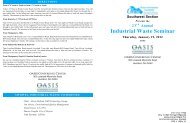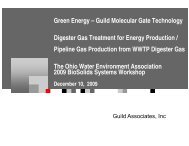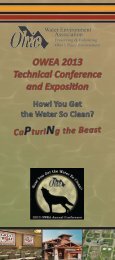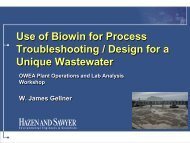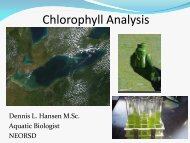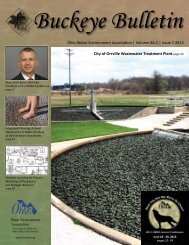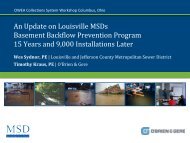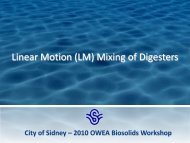PDF File
PDF File
PDF File
You also want an ePaper? Increase the reach of your titles
YUMPU automatically turns print PDFs into web optimized ePapers that Google loves.
Operational Challenges for<br />
Groundwater Discharge<br />
West-Central Ottawa WWTP<br />
Joe Hebert, Plant Operator<br />
MDEQ Licensed: C, L1, L2-R, S-3, S<br />
A-2b, A<br />
B2a, B3b<br />
Ottawa County Road Commission, Department of Public Utilities<br />
John Barszewski, Plant Operator<br />
MDEQ Licensed: B, S-4, S<br />
D-4, D<br />
(plus other numerous letters and numbers)<br />
Fishbeck, Thompson, Carr & Huber, Inc.
OTTAWA
Background<br />
• Ottawa County expanding for Sheriff’s<br />
Department, administrative offices, probate<br />
court, juvenile detention, and medium-<br />
security jail<br />
• July 1993 – Purchased existing WWTP from<br />
nearby trailer park<br />
• County proposed OCRC Department of<br />
Public Utilities (DPU) operate the facility<br />
• Retained FTC&H to help with plant<br />
operations
What is an Orbal?
Original Design<br />
• Headworks: Muffin Monster grinder<br />
and flow meter<br />
• 0.16-MGD, Envirex 3-ring 3<br />
orbal provides<br />
extended air treatment with two rotating disk<br />
aerators<br />
• One 24-foot<br />
foot-diameter secondary clarifier<br />
• Two 0.93-acre, 1.57-MG holding ponds<br />
• Two 0.75-acre groundwater discharge<br />
seepage basins<br />
• One 0.19-MG open sludge storage tank<br />
• Pumps: two RAS, two WAS, one sludge,<br />
two sludge decant, two clarifier scum
Recent WWTP Upgrade History<br />
• Struggled through low flows, cold<br />
temperatures, no redundancy, and difficulty<br />
achieving total inorganic nitrogen (TIN)<br />
removal from 1993 to 2003<br />
• Added internal recycle pump to improve TIN<br />
removal in 2001<br />
• Underwent plant expansion to 0.300 MGD<br />
from 2002 to 2003
Plant Expansion
Plant Expansion
Challenges<br />
• Plug flows directly from five lift stations<br />
(observed instantaneous flows of 1 MGD)<br />
• No solids removal at headworks<br />
• No onsite lab to provide same-day results<br />
• Achieving TIN removal to meet the<br />
permitted limit of 5 milligrams per liter (mg/l)<br />
(NH 3 + NO 2 + NO 3 = TIN)<br />
Ammonia + Nitrite + Nitrate<br />
• Winter (cold weather) operation
Removing TIN<br />
(starts with nitrification and BOD removal)<br />
• Typical Influent: 0.130 MGD<br />
BOD 230 mg/l -- 249 lbs/day<br />
NH 3 57 mg/l -- 62 lbs/day<br />
• Removal of BOD+NH 3 = 634 lbs O 2 required<br />
@ 0.160 MGD = 780 lbs O 2 required<br />
• 13 disks x 60 lbs/O 2 /day = 780 lbs O 2 delivered<br />
(provides a small amount of DO residual)<br />
• Result of NH 3 conversion is 10 to 20 mg/l NO 3
Removing Nitrate<br />
(The next step)<br />
• Provide carbon source (residual BOD within<br />
channel or split-feed influent)<br />
• Creating anoxic zones
Orbal Operation<br />
Direction<br />
of<br />
FLOW<br />
D.O. mg/l<br />
The DO Balancing Act<br />
• If the DO > 3 to 4 mg/l in ring 1 (innermost<br />
ring), OR<br />
If the DO in rings 2 and 3 does not drop < 0.5<br />
mg/l before the aerators, NO 3 will quickly rise<br />
above 5 mg/l in effluent<br />
• If the DO < 1.5 mg/l in ring 1, NH 3 and BOD<br />
will rise in effluent
Bio-P P Removal is an Additional<br />
Benefit of Denitrification<br />
• After denitrification, Bio-P P removal can begin<br />
with the right conditions<br />
• RAS (starved microorganisms) added near<br />
influent (carbon source)<br />
• RAS and influent added in an anoxic zone<br />
• Once nitrate is removed, P is released in the<br />
anoxic zone, then absorbed and consumed<br />
in the aerobic zone
Chemical Feed at W.C.O.<br />
• Influent: 8.8 mg/l = 11.7 lbs P/day @ .160 MGD<br />
• 20 gal/day Alum = 167 mg/l = 222 lbs/day<br />
• Mole ratio 0.9:1 (Aluminum:Phosphorus)<br />
• 11 lbs P/day is removed (94%)
Groundwater Discharge<br />
0.75-acre Seepage Bed
The End Result<br />
• Close attention to DO concentrations is a must<br />
when removing TIN<br />
• Cost savings with lower electrical usage<br />
(drive timers installed)<br />
• The right equipment makes the whole system<br />
work more efficiently (IR pump, VFD aerators,<br />
and online DO monitors)
Don’t t Forget an Operator’s<br />
Attention to Detail!
The #1 Work-Related Injury:<br />
Cranial-Rectal Inversion
John M. Barszewski<br />
FTC&H Wastewater Operations<br />
Email: jmbarszewski@ftch.com<br />
Telephone: (616) 464-3754



